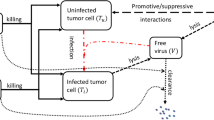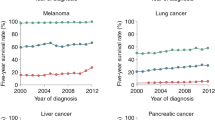Abstract
A long-pursued goal in cancer treatment is to deliver a therapy specifically to metastases. As a result of the disseminated nature of the metastatic disease, carrying the therapeutic agent to the sites of tumor growth represents a major step for success. We hypothesized that tumor cells injected intravenously (i.v.) into an animal with metastases would respond to many of the factors driving the metastatic process, and would target metastases. Using a model of spontaneous metastases, we report here that i.v. injected tumor cells localized on metastatic lesions. Based on this fact, we used genetically transduced tumor cells for tumor targeting of anticancer agents such as a suicide gene or an oncolytic virus, with evident antitumoral effect and negligible systemic toxicity. Therefore, autologous tumor cells may be used as cellular vehicles for systemic delivery of anticancer therapies to metastatic tumors.
This is a preview of subscription content, access via your institution
Access options
Subscribe to this journal
Receive 12 print issues and online access
$259.00 per year
only $21.58 per issue
Buy this article
- Purchase on Springer Link
- Instant access to full article PDF
Prices may be subject to local taxes which are calculated during checkout



Similar content being viewed by others
References
Rosenberg SA . Progress in human tumour immunology and immunotherapy. Nature. 2001;411:380–384.
Carter P . Improving the efficacy of antibody-based cancer therapies. Nat Rev Cancer. 2001;1:118–129.
Arap W, Pasqualini R, Ruoslahti E . Cancer treatment by targeted drug delivery to tumor vasculature in a mouse model. Science. 1998;279:377–380.
Hood JD, Bednarski M, Frausto R, et al. Tumor regression by targeted gene delivery to the neovasculature. Science. 2002;296:2404–2407.
Lyden D, Hattori K, Dias S, et al. Impaired recruitment of bone-marrow-derived endothelial and hematopoietic precursor cells blocks tumor angiogenesis and growth. Nat Med. 2001;7:1194–1201.
Sznol M, Lin SL, Bermudes D, et al. Use of preferentially replicating bacteria for the treatment of cancer. J Clin Invest. 2000;105:1027–1030.
Dang LH, Bettegowda C, Huso DL, et al. Combination bacteriolytic therapy for the treatment of experimental tumors. Proc Natl Acad Sci USA. 2001;98:15155–15160.
Alemany R, Balague C, Curiel DT . Replicative adenoviruses for cancer therapy. Nat Biotechnol. 2000;18:723–727.
Bell JC, Garson KA, Lichty BD, et al. Oncolytic viruses: programmable tumour hunters. Curr Gene Ther. 2002;2:243–254.
Shayakhmetov DM, Li ZY, Ni S, et al. Targeting of adenovirus vectors to tumor cells does not enable efficient transduction of breast cancer metastases. Cancer Res. 2002;62:1063–1068.
Liotta LA, Kleinerman J, Saidel GM . Quantitative relationships of intravascular tumor cells, tumor vessels, and pulmonary metastases following tumor implantation. Cancer Res. 1974;34:997–1004.
Fidler IJ . Metastasis: quantitative analysis of distribution and fate of tumor embolilabeled with 125 I-5-iodo-2'-deoxyuridine. J Natl Cancer Inst. 1970;45:773–782.
Nicolson GL . Organ specificity of tumor metastasis: role of preferential adhesion, invasion and growth of malignant cells at specific secondary sites. Cancer Metastasis Rev. 1988;7:143–188.
Liao F, Li Y, O'Connor W, et al. Monoclonal antibody to vascular endothelial-cadherin is a potent inhibitor of angiogenesis, tumor growth, and metastasis. Cancer Res. 2000;60:6805–6810.
Ruoslahti E, Giancotti FG . Integrins and tumor cell dissemination. Cancer Cells. 1989;1:119–126.
Muller A, Homey B, Soto H, et al. Involvement of chemokine receptors in breast cancer metastasis. Nature. 2001;410:50–56.
Felding-Habermann B, O'Toole TE, Smith JW, et al. Integrin activation controls metastasis in human breast cancer. Proc Natl Acad Sci USA. 2001;98:1853–1858.
Lillo R, Ramirez M, Alvarez A, et al. Efficient and nontoxic adenoviral purging method for autologous transplantation in breast cancer patients. Cancer Res. 2002;62:5013–5018.
Coukos G, Makrigiannakis A, Kang EH, et al. Use of carrier cells to deliver a replication-selective herpes simplex virus-1 mutant for the intraperitoneal therapy of epithelial ovarian cancer. Clin Cancer Res. 1999;5:1523–1537.
Al-Mehdi AB, Tozawa K, Fisher AB, et al. Intravascular origin of metastasis from the proliferation of endothelium-attached tumor cells: a new model for metastasis. Nat Med. 2000;6:100–102.
Liotta LA, Kohn EC . The microenvironment of the tumour–host interface. Nature. 2001;411:375–379.
Cameron MD, Schmidt EE, Kerkvliet N, et al. Temporal progression of metastasis in lung: cell survival, dormancy, and location dependence of metastatic inefficiency. Cancer Res. 2000;60:2541–2546.
Horino K, Kindezelskii AL, Elner VM, et al. Tumor cell invasion of model 3-dimensional matrices: demonstration of migratory pathways, collagen disruption, and intercellular cooperation. FASEB J. 2001;15:932–939.
Aboody KS, Brown A, Rainov NG, et al. Neural stem cells display extensive tropism for pathology in adult brain: evidence from intracranial gliomas. Proc Natl Acad Sci USA. 2000;97:12846–12851.
Harrington K, Alvarez-Vallina L, Crittenden M, et al. Cells as vehicles for cancer gene therapy: the missing link between targeted vectors and systemic delivery? Hum Gene Ther. 2002;13:1263–1280.
Holder JW, Elmore E, Barrett JC . Gap junction function and cancer. Cancer Res. 1993;53:3475–3485.
Mullen CA, Coale MM, Lowe R, et al. Tumors expressing the cytosine deaminase suicide gene can be eliminated in vivo with 5-fluorocytosine and induce protective immunity to wild type tumor. Cancer Res. 1994;54:1503–1506.
O'Reilly MS, Holmgren L, Shing Y, et al. Angiostatin: a novel angiogenesis inhibitor that mediates the suppression of metastases by a Lewis lung carcinoma. Cell. 1994;79:315–328.
Acknowledgements
We thank Isabel de los Santos, Pilar Hernández and Sergio García for technical assistance, and Dr José M. Martínez for his help with analyzing image files. This work was supported in part by Fundación Leucemia Linfoma (MR) and Fundación Oncohematología Infantil (JGC, LM and MR).
Author information
Authors and Affiliations
Corresponding author
Additional information
Supplementary information accompanies the paper on Cancer Gene Therapy website (http://www.nature.com/cgt).
Supplementary information
Rights and permissions
About this article
Cite this article
García-Castro, J., Martínez-Palacio, J., Lillo, R. et al. Tumor cells as cellular vehicles to deliver gene therapies to metastatic tumors. Cancer Gene Ther 12, 341–349 (2005). https://doi.org/10.1038/sj.cgt.7700801
Received:
Published:
Issue Date:
DOI: https://doi.org/10.1038/sj.cgt.7700801
Keywords
This article is cited by
-
Aptamer-facilitated Protection of Oncolytic Virus from Neutralizing Antibodies
Molecular Therapy - Nucleic Acids (2014)
-
Carrier cell-based delivery of replication-competent HSV-1 mutants enhances antitumor effect for ovarian cancer
Cancer Gene Therapy (2011)
-
Osteosarcoma cells as carriers to allow antitumor activity of canine oncolytic adenovirus in the presence of neutralizing antibodies
Cancer Gene Therapy (2010)
-
Potentiating Cancer Immunotherapy Using an Oncolytic Virus
Molecular Therapy (2010)
-
Taming the Trojan horse: optimizing dynamic carrier cell/oncolytic virus systems for cancer biotherapy
Gene Therapy (2008)



